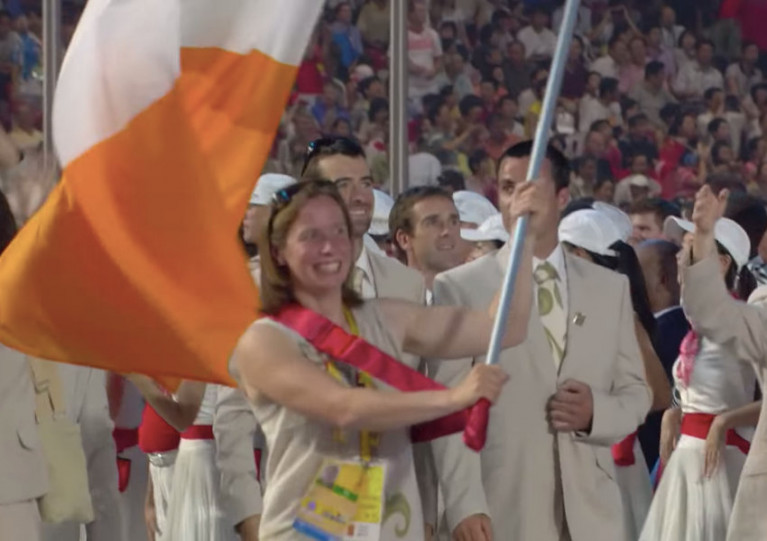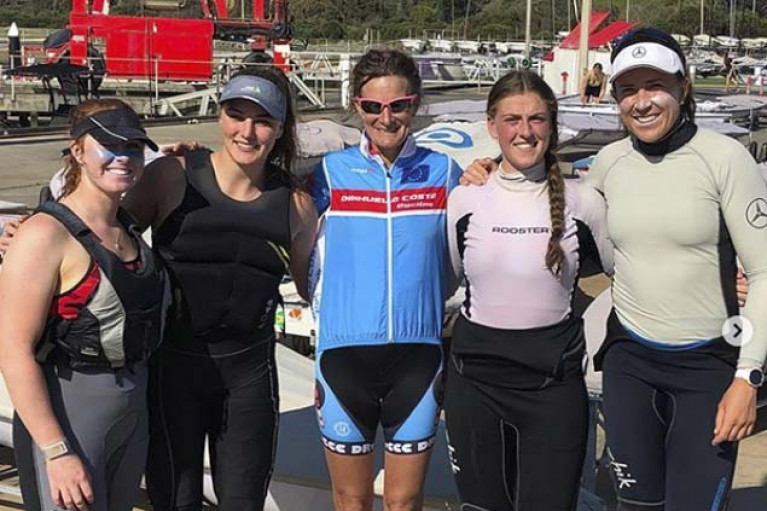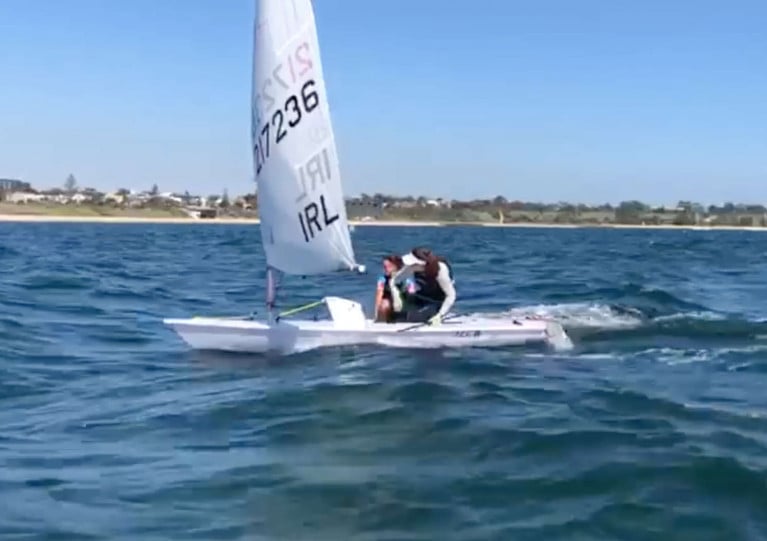Displaying items by tag: Laser Radial
Howth Yacht Club Radial Sailor Aoife Hopkins Moves Up to 20th Overall at Laser World Championships in Oman
Howth Yacht Club sailor Aoife Hopkins improved her overall standing at the women's Laser Radial (ILCA6) World Championships in Mussanah today after two further light air races and a long day afloat.
Hopkins finished 16th and 15th for 20th place overall. Her placing has improved steadily from 31st overall since Thursday in the 63-boat fleet.
Light winds continue to dominate the regatta that is being officiated by Principal Race Officer Con Murphy of Dun Laoghaire. The fleet waited at sea for two hours before just enough breeze filled in to get racing.
Overall, Agata Barwinska of Poland leapfrogged Julia Büsselberg to climb from third to first, leaving Büsselberg in second place for the second day in a row. Emma Plasschaert of Belgium moved up to third.
However, the day belonged to Cristina Pujol Bajo of Spain who rose through the rankings to end the day in fourth after winning one race and finishing fourth in another. Olympic Champion Anne-Marie Rindom of Denmark sits in fifth with Viktorija Andrulyte of Lithuania a point behind having dropped from fourth to sixth today. Eleven points separate first and sixth, so it could all change again tomorrow.
Viktorija Andrulyte of Lithuania, said, “Today, as has become usual, we are waiting for the wind to pick up. The wind has been unstable all day, so we were able to start. Two races today. I didn’t start well but climbed up, even to first, but lost pace in the down while trying not to get a yellow flag. But I also made some mistakes. I also picked up a penalty for an incident, but I still tried my best to the very end and finished top 20. I am improving and not losing as much in the downwind, so I am really happy about that.”
Hannah Anderssohn of Germany, said, “The races were quite tough for me, I had a very difficult start. But slowly I am improving and going a bit better. In general, it is very difficult to get off the start line.”
Rosie Chapman, US Sailing coach, said, “It’s a big fleet, really awesome to see so many people make it to Oman. We have had a challenging start to the regatta and there hasn’t been a world championship for a couple of years but it is exciting to see the level of the fleet and how far it has come since the last regatta. Having had a delay on the Olympic Games, the girls coming straight from the Games are pretty busy for the next quad and there are some younger girls coming through and challenging everybody, so it’s really good to see that. The key names are here and the young girls are coming up and making a difference.”
The high scores continue to be a feature in the fleet so nothing can be taken for granted with two days of racing remaining.
Organisers will continue to plan for three races on each of the remaining days to sail as many of the races as possible.
Results are downloadable below
Fans Pay Tribute as Annalise Murphy Calls Time on Olympic Career
Fans and supporters of Annalise Murphy have paid tribute to the Irish sailing star after she suggested that her Olympic career was now at a close after failing to make her Tokyo 2020 final.
As previously reported on Afloat.ie, Murphy finished the week on Friday (30 July) in 18th overall, placing her outside the top 10 who qualified for this morning’s (Sunday 1 August) Laser Radial medal race in which Denmark’s Anne-Marine Rindom took gold after a misunderstanding of race rules cost her a big points lead.
Speaking after her own last race at Enoshima, Murphy — who won Olympic silver in the Laser Radial in Rio five years ago — said she was “really proud of how I managed to come back this week”.
That was in reference to her preferred stronger wind conditions which prevailed in her one-two finish in Thursday’s racing.
She told RTÉ Sport: “I was hoping we were going to get more conditions like [Thursday], I knew that I would excel in those kind of conditions and I'm really glad we managed to get one day of it to show I can still be the best when the day comes around.”
'I can't see myself going to another Olympics'
— RTÉ Sport (@RTEsport) July 30, 2021
An emotional @Annalise_Murphy chats to @joestack_ky as she contemplates bringing the curtain down on her #sailing career#olympics #tokyo2020 #RTESport
? Watch live - https://t.co/lLKXNhKPkF
? Report - https://t.co/NEkif5zFR3 pic.twitter.com/kQgjwl65e9
As for what the future holds, Murphy said she is “looking forward to a normal life” and that she “can't see myself going for another Olympics” — adding that she wants to help out fellow Irish Laser Radial sailors Aoife Hopkins and Eve McMahon with their campaigns.
“I hope I can give them some of my knowledge and maybe they can surpass all of my achievements. That would the dream, that I have left some legacy behind,” she added.
Following Murphy’s comments, fans on social media expressed their admiration for her Olympic achievements and as a sportswoman in general.
Twitter user suz kavanagh said: “Such ability, dedication and strong attitude, a true Olympian.. it’s been an honour to follow your journey. Be proud!”
Stuart Masterson said Murphy has “raised the profile of sailing in Ireland. The fact that you are talking up the next generation of sailors speaks volumes about how great of a person you are, not just a great sports person.”
Meanwhile on Facebook, Karin Duffy said Murphy is “an amazing ambassador for Irish sailing and inspiring role model for all the young aspiring athletes”, and Katy Moore Ratcliffe thanked her “for representing the Irish with class”.
If Anne-Marie Rindom (DEN) doesn’t win gold after Sunday’s Medal Race, the mistakes of today will haunt her for the rest of her life.
Much lighter wind conditions make for a lot more jeopardy in the Laser Radial. Not only is the wind hard to read when it’s in short supply, but the risk of being penalised for propelling the boat forward illegally through excessive body movement, fanning the sails or wagging the tiller to promote forward motion increases. The result can be a yellow flag from the on-water-jury. A first offence is a 720-degree penalty turn during the race and a second offence requires the sailor to retire from the race.
As Afloat reported earlier, Rindom explained the nightmare scenario for her in the final race of the Laser Radial Opening Series, "I got a yellow flag in the first one for pumping up the downwind and then in the second start, I got the second yellow flag, which means that you have to retire from the race. And so I did.
"But then there was a general recall so there was a new start. I didn't have enough time to talk to my coach if I could start or not. I simply didn't know the rule that I could start in that race. I decided to start but then I decided to retire because I wasn't sure and I didn't want to get a DNE [non-discardable disqualification].
"Obviously that was wrong and I can only blame myself. I guess I should have known the rule. But I've never been in this situation in my whole career."
For all that, Rindom still holds a seven-point advantage over arch-rival Marit Bouwmeester going into Sunday’s Medal Race. But today could have been the day that the Dane had put a padlock on the gold medal, just as Kiran Badloe (NED) did 24 hours before on his RS:X Windsurfer.
"I’m just devastated right now, it's hard to be in my own body with so many emotions. But yeah, I just have to rise again and be ready for Sunday because nothing is over yet."
Yesterday Bouwmeester’s hopes of the gold medal looked dead and buried, but Rindom’s pain is the defending Olympic Champion’s opportunity. It’s a huge momentum swing in favour of the Netherlands.
This is not as simple as a two-horse race, however. Josefin Olsson holds bronze medal position and the Swede, along with Canada, Belgium, Italy and Finland all have a shot at the podium this Sunday.
Aisling Keller Has Every Right to Feel Hard Done By Over Olympics Exclusion, Says Nenagh Guardian
The process by which Laser Radial sailor Aisling Keller was excluded from this summer’s Olympic Games “leaves a lot to be desired”, according to an editorial in her home town’s newspaper.
The Lough Derg Yacht Club racer secured Ireland’s Laser Radial spot in Tokyo with a strong performance at her class’s Worlds in Japan two years ago.
But Nenagh native Keller was denied a chance to compete for that place when last year’s Olympic trials were cut short amid the early months of the COVID-19 pandemic.
Instead, Irish Sailing opted to select Rio 2016 silver medalist Annalise Murphy — a recent returnee to the class after an abandoned run in the 49erFX.
As previously reported on Afloat.ie, Keller and fellow hopeful Aoife Hopkins were respectively “upset” and “devastated” by the decision.
And the Nenagh Guardian editorial says Keller has every right to feel hard done by.
“Now, Annalise might well be our best chance of winning a medal,” the paper writes, “but being handed the opportunity was blatantly unfair, when over the last twelve months, a competition could have taken place on these shores for both, or indeed Aoife Hopkins and Eve McMahon who were also in the running.”
The editorial makes no bones about the situation as it sees it: “Where competitors for Olympics are based on selection rather than out and out competition, it is open to bias and influence and it is hard not to feel that Keller … just didn’t have the right connections with the right people compared to others.”
Irish Sailing said at the time of its announcement that “Annalise’s performance in the 2020 Worlds made her a clear favourite to win the scheduled trials. By nominating her now, the Irish Sailing Board has ensured that team preparations can focus on the Olympics rather than preparing for domestic trials”.
Annalise Murphy Takes Laser Radial Title At Italian Olympic Week
The National Yacht Club’s Annalise Murphy held her lead over the 41-boat fleet to claim the Laser Radial open class title in the final racing of Italian Olympic Week at Follonica.
Murphy’s third place finish yesterday (Sunday 20 September) was enough to maintain the points gap over Italy’s Silvia Zennaro, with Norway’s Line-Flem Höst third in the provisional overall table.
The result will be a significant boost Murphy’s delayed Laser Radial campaign, although many of her key rivals for Tokyo 2020 gold next year did not contest the Italian championships. Next up are the European Championships in Gdansk two weeks from tomorrow.
Meanwhile, despite their early exit to get home to Ireland before new ‘green list’ restrictions came unto force, Ewan McMahon and Finn Lynch both finished in the top 10 in the Laser standard class, as previously reported on Afloat.ie.
Today is the day athletes from around the world would have been celebrating the start of the Tokyo 2020 Olympics at the opening ceremony, writes Gail McAllister.
In many ways it marks the culmination of lifelong dreams, for 2020 the dream is postponed for a year.
So let’s reflect and rewind the clock to this day in 2008, when Olympic Laser Radial sailor Ciara Peelo from Malahide stepped out into the Bird’s Nest, Beijing’s National Stadium, as the flag bearer for the entire Irish Olympic team.
470 sailors Ger Owens and Phil Lawton walked alongside Star sailors Peter O’Leary and Steve Milne, giving Ciara encouragement to “keep on waving that flag” as the thousands of spectators and millions of viewers across the world roared their support.
Today is the day to reminisce with Ciara on her memories of the day.
“Sheer total happiness,” Ciara said. “There was such a happy and enthusiastic atmosphere in the team as we walked into the stadium and the noise was brilliant as we entered the arena of 91,000 spectators, and athletes of all shapes and sizes from the four corners of the world.”
Just look at the smile on Ciara's face; it sums up pride, achievement and happiness…
How did it feel to be chosen to carry the flag?
I got called to a meeting at the Olympic Federation offices in Howth and I thought I was meeting the performance director, James O’Callaghan. They asked if I was willing to take the flag at the opening ceremony. It was a huge honour and surprise to be asked, so of course, the answer was yes.
Sonia O’Sullivan carried the flag and she was my idol growing up, so to have the opportunity to follow in the footsteps of my sporting hero was incredible.
Do you reflect back on the Beijing Olympics?
Yes and no. I went to the Olympics to perform in sailing and I came home feeling like I had not achieved my personal goals. The opportunity only comes around once in every four years and if you don’t achieve in that one event you will naturally be disappointed and are left with a feeling of unfinished business.
I now look back and reflect more positively on the experience. I remember the incredible journey up to and during the event and the milestones along the way.
Have you learnt anything from that emotion?
Yes. Acceptance. I approach and do things very differently now. The journey is as important as the final event. It is hard to see this when you are in the thick of competition. I learnt it was important for me to be happy with what I am doing in life as a whole and I make decisions based on happiness and contentment.
You now work as a teacher. Do you share your outlook and learnings?
I work on teaching the person and teaching the subject becomes part of that. Making sure that the person is learning what they need to learn in a way that works for them is important.
As you know, there is now a High Performance Centre in Dun Laoghaire. Do you look at the facilities that are available now for Olympic campaigners and compare to what you had available?
Everything has progressed and improved on a continuous basis. Post-Beijing a coach was brought in for the Radials and the squad was set up. There has been so much progression across the whole programme from where we were 12 years ago. As you would expect.
James, as performance director, is always looking to do the next thing to be successful. He knew Irish sailing needed squads, coaches and the right set up working with the team and he made it happen. We can all see that the performance speaks for itself.
What additional professional support did you have in 2008?
We had Sports Med Ireland, sports psychology and a nutritionist in the 2008 cycle. These were important and they are now integrated in the programme from Academy level. The athletes get more face time now with support team professionals which is a great step forward but clearly places a demand on resource.
Any advice for young athletes out there?
Choose your goal, your passion. If you want it, then go out and do it. You will feel a better person.
In conversation with Gail McAllister
Aoife Hopkins will not appeal last week’s decision to cut-short the Radial Olympic trial for Tokyo 2021 as Howth Yacht Club, expressed its disappointment for both the former U21 European Champion and clubmate Eve McMahon, both contestants in the Irish trials.
Irish Sailing announced its decision to select Rio silver medalist Annalise Murphy, after only one of a series of three trials had been sailed.
Hopkins (21), who was Murphy's (30) nearest rival for the single Tokyo berth, was left 'devastated' last week when the trials were stopped.
"I really can’t understand the decision not to continue with the trials. I am utterly and completely devastated", she told Afloat after the decision.
Speaking at the weekend, Howth Yacht Club Commodore Ian Byrne told Afloat 'Our club is naturally disappointed for Aoife and Eve and that they didn’t get the chance to follow through with their campaigns'.
Under the selection process, if one or more of the trial regattas are cancelled, then the person with the best performance in the completed trial regattas secures the nomination.
Murphy finished the ILCA Laser Radial Women’s World Championship in 12th place, Hopkins finished in 40th, Aisling Keller 63rd, and Academy sailor McMahon 78th.
The manner in which the decision was made and conveyed to Hopkins took her and supporters aback last Monday, (including some sponsors), given that the Olympics is still a year away, adding heft to her argument there was plenty of time to complete the trials series among the four Irish contestants.
Hopkins club has expressed its disappointment at the decision despite the fact that the Rio silver medalist may have set a tough target for the others after a top placing at February's World Championships.
Hopkins is arguably the most affected by the decision, given the length of her campaign and also that she might have expected to be in Tokyo, before Annalise’s return to the class after she gave up on the 49er FX last September.
Hopkins also had a club rival in young Academy sailor Eve McMahon who had been given the chance to contest the trial as a 16-year-old, so the Radial trial was of significant interest at Ireland's biggest yacht club.
McMahon is playing a ‘long game’, with a clear focus on future campaigns. A talented racer, she already has what it takes to compete at the highest level and was crowned U17 champion at the Worlds in February.
Hopkins says she is taking time out to reassess her situation.
'Aoife is a talented and hard-working competitor and once she’s had the time to reflect on her situation, she will emerge stronger than ever, Howth's Brian Turvey told Afloat. 'it’s easy to forget that Eve is still only 16 years of age and she has a terrific future ahead of her'.
'We have followed their progress and supported their campaigns since their first aspirations in competition and we are gutted for them after what must feel like a lifetime of commitment', Commodore Byrne added.
We wish Annalise well and hope that Irish Sailing’s interjection in this process produces the right result, the HYC Commodore said.
As Afloat previously reported, Irish Sailing's James O'Callaghan said "Annalise’s performance in the 2020 Worlds made her a clear favourite to win the scheduled trials. By nominating her now the Irish Sailing Board have ensured that team preparations can move focus to the Olympics rather than preparing for domestic trials”.
He went on to say: “for sure this is tough on Aoife but she is still very young and can benefit massively from team training planned in Tokyo”.
O'Callaghan said at the weekend that no appeals against the decision had been received. Murphy's nomination will be put forward to the Olympic Federation of Ireland for ratification.
Annalise Murphy Adapts In The Time Of Coronavirus
“In my head I was going, ‘If I give up here, they’re going to be saying that Annalise The Olympian has just quit’. So I couldn’t quit.”
That’s how Annalise Murphy explains her motivation to keep up her fitness and focus for the next Olympics in the time of coronavirus, in an interview with Malachy Clerkin in The Irish Times this weekend.
The Laser Radial silver medallist was counting down the days to the Tokyo 2020 games when two months ago the world began to shut down in efforts to contain the spread of Covid-19.
Within a matter of weeks, the event she and thousands of other athletes had been working towards for months, if not years, was suddenly another year away.
And what’s more, movement restrictions prevented her from even taking to the water for training — and it’s still not entirely clear when that will resume. “I do really miss sailing right now,” she says.
In the meantime, the Irish hero of Rio 2016 has had to refocus her energies, training as much as she can at home.
But the situation, in giving her more time to think about her quest for Ireland’s reserved Laser Radial spot in Tokyo, has also had the side effect of expanding her ambitions.
“Initially, I was very much thinking I was going to retire after the Olympics,” she explains. “But after the Worlds [in February] I was going, ‘Well, I don’t know if I can retire now – I need to go and try to win a Worlds before I retire.’
The Irish Times has much more on the story HERE.
Four Irish Laser Radial Girls Prepare for First Olympic Trial at Melbourne World Championships
Four Irish women will be on the start line of the first race of 2020 Laser Radial World Championships this Sunday.
As Afloat previously reported, this is the first of three Irish trial regattas for the Olympic place and each sailor will be seeking to carry the minimum number of points into the next round at Palma in March. The final event is in Hyeres, France in April. The selection regattas were changed late last year by mutual agreement, dropping the World Cup in Genoa in favour of the World Championship in Melbourne.
In part of the buid up to Sunday's first races, the girls were joined at their Melbourne training camp by local resident and Irish athletics great Sonia O’Sullivan who reported on the trials in her weekly Irish Times column.
Aoife Hopkins
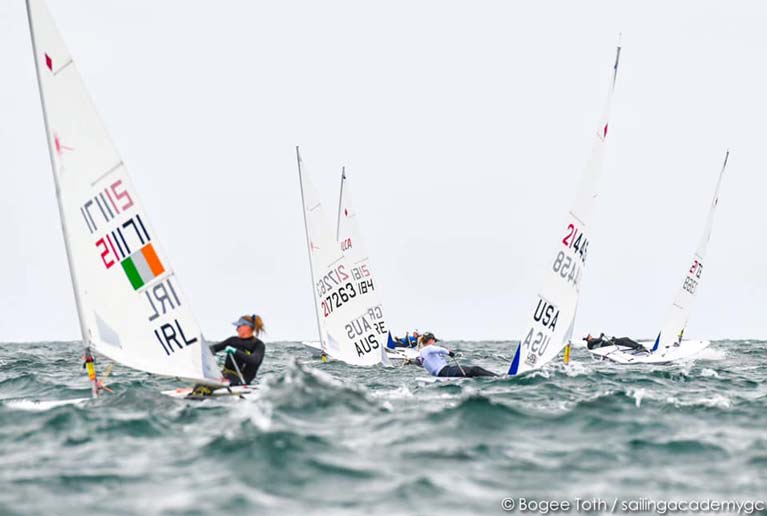 Aoife Hopkins (left)
Aoife Hopkins (left)
Highest ranked (39th) is Aoife Hopkins (21) of Howth Yacht Club who has campaigned consistently over the last two years, and will be targeting a second successive World Championship gold fleet result to maintain her selection hopes. Hopkins finished 25th in last month’s Sail Melbourne against quality opposition.
Aisling Keller
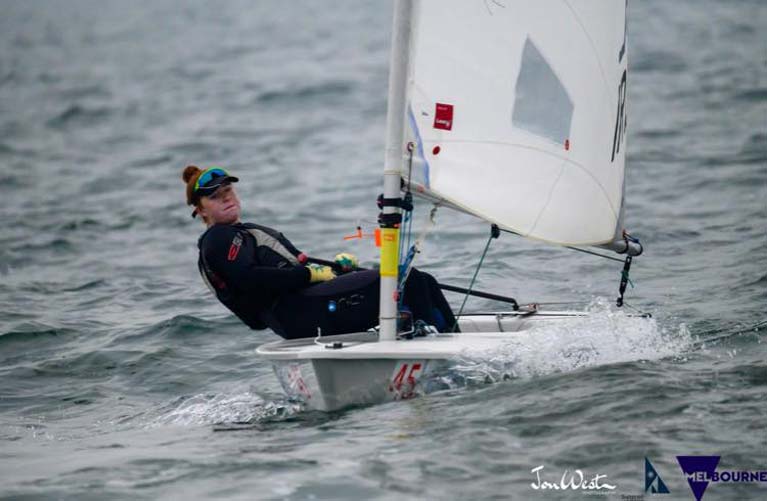 Aisling Keller
Aisling Keller
Lough Derg Yacht Club’s Aisling Keller (23), ranked 63rd, finished 3 places behind Hopkins in Melbourne, but two places ahead at last year’s Worlds, qualifying the country in the process. These pair were locked in a battle for the Olympic berth, but the return of Annalise Murphy to the fray has created a new challenge where they will need to look beyond their own private battle.
Annalise Murphy
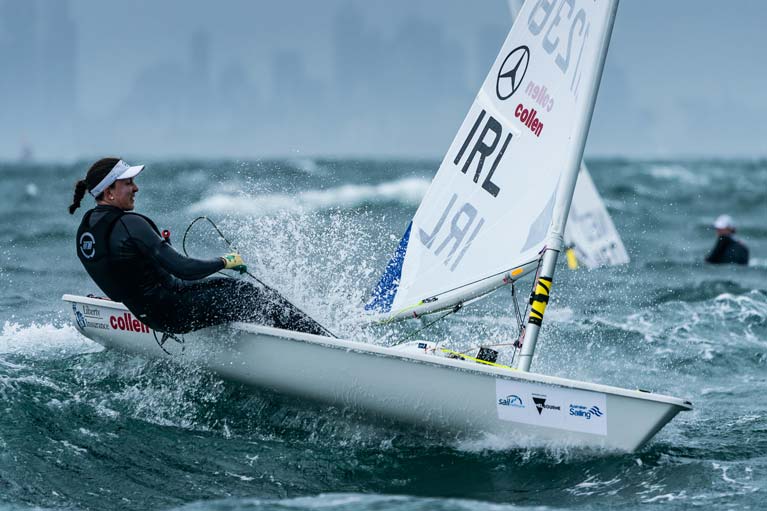 Annalise Murphy
Annalise Murphy
2016 Rio silver medallist Murphy (30), has a lowly ranking of 136th due to her late return to the class. The National Yacht Club sailor has directed her talent elsewhere since her medal performance, crewing in the Volvo Ocean Race and attempting to develop a 49erfx challenge. She took up where she left off, in battle with Rio Gold Medallist Marit Bouwmeester (NED) for honours in Sail Melbourne, once again taking the runner-up spot.
Eve McMahon
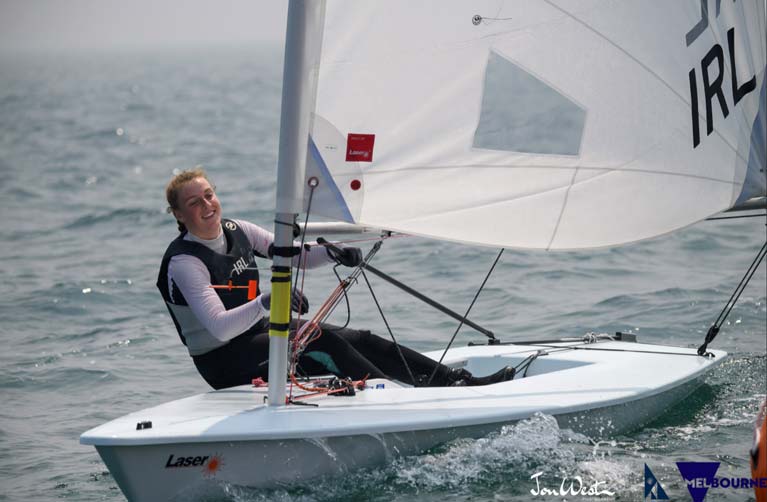 Eve McMahon
Eve McMahon
Eve McMahon (15), Howth Yacht Club, is the current under 17 Laser Class World Champion. Ranked 144th in the world, she has displayed her considerable potential by finishing 46th in Sail Melbourne and poses an interesting question as to whether her upward trajectory can put her in the mix for selection.
The weather will play a significant part in determining the outcome of this first trial. Sail Melbourne, with the exception of the final race, was a windy regatta, playing to Murphy’s strength. The forecast for the first three days of the World Championship, predicts mixed strengths, but perhaps closer to 10 knots than 15 knots.
First race reports on Afloat are expected on Sunday morning, Irish time.
All three medallists from the Rio Olympics will take to the water off Sandringham Yacht Club on Sunday. They head a star-studded field of 106 competitors from 40 countries, many of whom will be trying to qualify as their country's representative at Tokyo 2020.
Leading the charge will be Marit Bouwmeester from the Netherlands, the 2016 gold and 2012 silver medallist at the Olympics and a six-times world champion in the event. Marit has been training in Melbourne since December and won the Australian Championship in early January. Although she has already been selected for the Olympics by the Dutch Federation, she will still have a battle on her hands during the Worlds from countrywomen Mirthe Akkerman, Maxim Jonker and Daphne van der Vaart, who all pushed her during the Australian Championship.
Anne-Marie Rindom (DEN) is ranked number one in the world at present and is the defending world champion, having also won the title in 2015. She was 13th at the London Olympics and won the bronze medal in Rio.
Annalise Murphy (IRL) was part of an epic Laser Radial medal race at the London Olympics, where she missed out on the bronze by the barest of margins. She made up for that at Rio, taking silver behind Marit Bouwmeester.
Another former world champion, Alison Young of Great Britain, is currently ranked second in the world while Emma Plasschart of Belgium is ranked third.
Among those competing for a place at the Olympics are two Finn sailors, Tuula Tenkinen and Monika Mikkola. Ranked ninth and 14th respectively, they present a welcome challenge to the Finn selectors.
Even more intense will be the rivalry for Kim and Lin Pletikos of Slovenia, who are not only competing for an Olympic spot, but for bragging rights around the family dinner table.
The home crowd is also hoping to see a sailor selected for Tokyo.
There are 19 Australians in the field for the Worlds. Assuming there are no upsets, either Thomson or Stransky will need to finish in the top 10 to secure a seat on the plane to Tokyo
The Heat Is On For Ireland’s Quartet Of Laser Radial Sailors Competing For Tokyo Olympic Spot
In her latest column for The Irish Times, athletics great Sonia O’Sullivan meets the four women in contention for Ireland’s sole Laser Radial spot at the Olympic Games in Tokyo this summer.
After frustrations in her attempt to qualify in the two-handed 49erFX class, Annalise Murphy is back in the boat with which she won silver at the 2016 Olympics — Ireland’s strongest Olympic sailing result to date.
But this time there is tough competition from three women who were still coming up when she was racing for that medal in Rio — namely Aisling Keller, Aoife Hopkins and 15-year-old Eve McMahon.
All four have been training together in Melbourne, Australia since the start of the year, ahead of the Laser Radial World Championship (starting tomorrow, Friday 21 February) which will be the first of three chances between now and April for one of them to secure that coveted spot.
“Think about how that must be for them,” writes Sonia. “They know that only one of them will go to Tokyo so they wouldn’t be human if they didn’t have some sort of selfish instinct in them. It would be only natural for them to keep little bits and pieces that they’re learning back for themselves to give them a better chance of being the one who gets the spot on the boat.
“But they also know that the more they push each other, the better they make each other. And the better they make each other, the greater chance of a medal for Ireland and a better all round result for Irish sailing.”
Sonia also gets out on the water with Annalise to experience first-hand the speed and excitement of the Laser Radial — and the rush Annalise and her fellow challengers will be feeling when the training is done and the race is on.




























